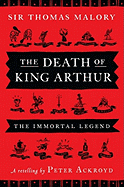
Sir Thomas Malory's version of the King Arthur legend, Le Morte d'Arthur was "published" in 1485 by William Caxton, 15 years after the author's death. Today, we're probably most familiar with the stories of Camelot through T.H. White's The Once and Future King or John Boorman's Excalibur (or even Monty Python and the Holy Grail). Do we need another version? Peter Ackroyd thinks we do and has returned to the source to recast Malory's story in a contemporary idiom. It's all here--Arthur and Merlin, the sword in the stone, the Round Table, the courtly love--and it makes for a very entertaining and exciting history lesson.
Ackroyd wants to preserve the "majesty and pathos" of Malory, but he also wants his "loose" rendition to be a shorter, more compact tale, emphasizing the story's steady pace, with its battles and adventures, its knights and ladies, its magic, above the original's more rambling and digressive telling. Reading Malory in the original Middle English can be a struggle, and though one can get used to it, the difference between "and desired to have lyen by her" and Ackroyd's "he looked at her with lust and cunning" demonstrates why he wanted to provide an "updated" yet "authentic" Death of King Arthur for a new and younger audience. --Thomas Lavoie, former publisher

